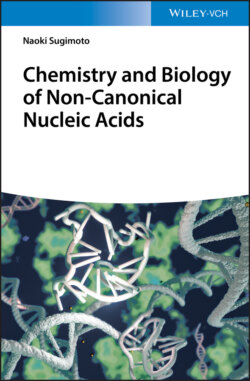Читать книгу Chemistry and Biology of Non-canonical Nucleic Acids - Naoki Sugimoto - Страница 2
Table of Contents
Оглавление1 Cover
2 Title Page
3 Copyright
4 Preface
5 1 History for Canonical and Non-canonical Structures of Nucleic Acids 1.1 Introduction 1.2 History of Duplex 1.3 Non-Watson–Crick Base Pair 1.4 Nucleic Acid Structures Including Non-Watson–Crick Base Pairs 1.5 Perspective of the Research for Non-canonical Nucleic Acid Structures 1.6 Conclusion and Perspective References
6 2 Structures of Nucleic Acids Now 2.1 Introduction 2.2 Unusual Base Pairs in a Duplex 2.3 Non-canonical Backbone Shapes in DNA Duplex 2.4 Branched DNA with Junction 2.5 Multi-stranded DNA Helices 2.6 Structures in RNA 2.7 Conclusion References
7 3 Stability of Non-canonical Nucleic Acids 3.1 Introduction 3.2 Factors Influencing Stabilities of the Canonical Duplexes 3.3 Thermodynamic Analysis for the Formation of Duplex 3.4 Factors Influencing Stabilities of the Non-canonical Nucleic Acids 3.5 Thermodynamic Analysis for the Non-canonical Nucleic Acids 3.6 Conclusion References
8 4 Physicochemical Properties of Non-canonical Nucleic Acids 4.1 Introduction 4.2 Spectroscopic Properties of Non-canonical Nucleic Acids 4.3 Chemical Interactions on Non-canonical Nucleic Acids 4.4 Chemical Platform on the Non-canonical Structures 4.5 Physicochemical Property of Non-canonical Nucleic Acids in Cell 4.6 Conclusion References
9 5 Telomere 5.1 Introduction 5.2 Structural Properties of Telomere 5.3 Biological Relevance of Telomere G4 5.4 Other Non-canonical Structures Related to Telomere Region 5.5 Conclusion References
10 6 Transcription 6.1 Introduction 6.2 Transcription Process 6.3 Transcription Process Perturbed by Certain Sequences of DNA and RNA 6.4 Transcription Process Perturbed by Non-canonical Structures of DNA and RNA 6.5 Conclusion References
11 7 Translation 7.1 Introduction 7.2 RNAs Involved in Translation Machinery 7.3 General Process of Translation 7.4 RNA Structures Affecting Translation Reaction 7.5 Conclusion References
12 8 Replication 8.1 Introduction 8.2 Replication Machineries 8.3 Replication Initiation 8.4 DNA Strand Elongation 8.5 Termination of Replication 8.6 Chemistry of the Replication and Its Regulation 8.7 Conclusion References
13 9 Helicase 9.1 Introduction 9.2 Function and Structure of Helicases 9.3 Unwinding of Non-canonical DNA Structures by Helicases 9.4 G4 Helicases in Gene Expressions 9.5 G4 Helicases in Replication 9.6 G4 Helicases in Telomere Maintenance 9.7 Relation to Diseases by Loss of G4 Helicases 9.8 Insight into Specific Properties of Activities of G4 Helicase Under Cellular Conditions 9.9 Conclusion References
14 10 Dynamic Regulation of Biosystems by Nucleic Acids with Non-canonical Structures 10.1 Introduction 10.2 Time Scale of Biological Reactions 10.3 Processes in the Central Dogma Affected by Dynamics of Nucleic Acid Structures 10.4 Conclusion References
15 11 Cancer and Nucleic Acid Structures 11.1 Introduction 11.2 Detail Mechanism of Cancer 11.3 Non-canonical Structures of Nucleic Acids in Cancer Cells 11.4 Roles of Non-canonical Structures of Nucleic Acids in Cancer Cells 11.5 Conclusion References
16 12 Neurodegenerative Diseases and Nucleic Acid Structures 12.1 Introduction 12.2 Protein Aggregation-Induced Neurodegenerative Diseases 12.3 DNA Shows Key Role for Neurodegenerative Diseases 12.4 RNA Toxic Plays a Key Role for Neurological Diseases 12.5 Conclusion References
17 13 Therapeutic Applications 13.1 Introduction 13.2 Oligonucleotide Therapeutics 13.3 Non-canonical Nucleic Acid Structures as Therapeutic Targets 13.4 Non-canonical Nucleic Acid Materials for Inducing Non-canonical Structures 13.5 Conclusion References
18 14 Materials Science and Nanotechnology of Nucleic Acids 14.1 Introduction 14.2 Non-canonical Structure-Based Nanomaterials Resembling Protein Functions 14.3 Protein Engineering Using G4-Binding Protein 14.4 Regulation of Gene Expression by G4-Inducing Materials 14.5 Environmental Sensing 14.6 Conclusion References
19 15 Future Outlook for Chemistry and Biology of Non-canonical Nucleic Acids 15.1 Introduction 15.2 Exploring Potential: Properties of Non-canonical Structures in Unusual Media 15.3 Systemizing Properties: Prediction of the Formation of Non-canonical Nucleic Acids Structures 15.4 Advancing Technology: Applications of Non-canonical Structures Taking Concurrent Reactions into Account 15.5 Conclusion References
20 Index
21 End User License Agreement
